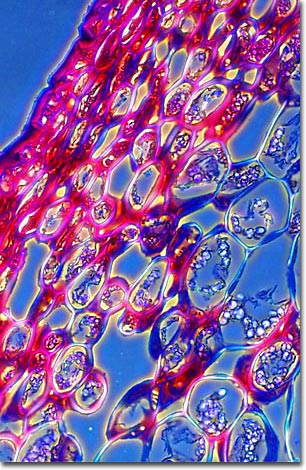Phase Contrast Image Gallery
Apple Scab (Venturia inaequalis)
The photomicrograph below illustrates a stained thin section of apple tree stem infected with apple scab, a destructive disease of apple trees caused by the fungus Venturia inaequalis. Apple scab is one of the most serious diseases of apple trees and occurs wherever apples are grown. It can also infect crab apple and mountain-ash trees.

This disease can cause serious losses in crop yields, 70 percent or higher, particularly during cool, damp spring weather. Losses result from scab-like spots on fruit or leaves. If enough leaves are damaged, the tree is left nearly defoliated and unable to grow or produce fruit.
A fungus, Venturia inaequalis, causes Apple scab. This fungus reproduces both sexually and asexually and the spores from both types of reproduction can infect plants. It is the asexual spores (conidia), however, that cause the most severe damage.
According to a recently adopted convention in botany, the asexual form of Venturia inaequalis has a different species name, Spilocaea pomi. This naming convention has been adopted to differentiate the asexual forms of certain groups of fungi because these stages are so distinct from the sexual forms. Most fungi, in fact, are known only in their asexual, or imperfect, forms. Mycologists, scientists who study fungi, are investigating many of these species to learn and describe their sexual, or perfect, stages.
BACK TO THE PHASE CONTRAST GALLERY
